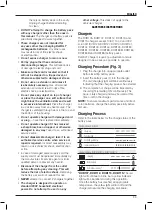
39
english
other voltage.
This does not apply to the
vehicular charger.
SAVE THESE INSTRUCTIONS
Chargers
The DCB105, DCB107, DCB112, DCB113 and
DCB115 chargers accept 10.8V, 14.4V and 18V
Li-Ion XR (DCB123, DCB127, DCB140, DCB141,
DCB142, DCB143, DCB144, DCB145, DCB180,
DCB181, DCB182, DCB183, DCB183B, DCB184,
DCB184B and DCB185) battery packs.
D
e
WALT
chargers require no adjustment and are
designed to be as easy as possible to operate.
Charging Procedure (Fig. 3)
1. Plug the charger into an appropriate outlet
before inserting battery pack.
2. Insert the battery pack (F) into the charger.
The red (charging) light will blink continuously
indicating that the charging process has started.
3. The completion of charge will be indicated by
the red light remaining ON continuously. The
pack is fully charged and may be used at this
time or left in the charger.
NOTE:
To ensure maximum performance and life of
Li-Ion batteries, charge the battery pack fully before
first use.
Charging Process
Refer to the table below for the charge status of the
battery pack.
Charge indicators: DCB105
charging
fully charged
hot/cold pack delay
replace battery pack
Charge indicators: DCB107, DCB112, DCB113, DCB115
charging
fully charged
hot/cold pack delay*
* DCB107, DCB112, DCB113, DCB115:
The red
light will continue to blink, but a yellow indicator
light will be illuminated during this operation.
Once the battery has reached an appropriate
temperature, the yellow light will turn off and the
charger will resume the charging procedure.
there is no battery pack in the cavity.
Unplug charger before attempting
to clean.
• DO NOT attempt to charge the battery pack
with any chargers other than the ones in
this manual.
The charger and battery pack are
specifically designed to work together.
• These chargers are not intended for
any uses other than charging
D
e
WALT
rechargeable batteries.
Any other uses
may result in risk of fire, electric shock
or electrocution.
• Do not expose charger to rain or snow.
• Pull by plug rather than cord when
disconnecting charger.
This will reduce risk
of damage to electric plug and cord.
• Make sure that cord is located so that it
will not be stepped on, tripped over, or
otherwise subjected to damage or stress
.
• Do not use an extension cord unless it
is absolutely necessary.
Use of improper
extension cord could result in risk of fire,
electric shock, or electrocution.
• Do not place any object on top of charger
or place the charger on a soft surface that
might block the ventilation slots and result
in excessive internal heat.
Place the charger
in a position away from any heat source. The
charger is ventilated through slots in the top and
the bottom of the housing.
• Do not operate charger with damaged cord
or plug
— have them replaced immediately.
•
Do not operate charger if it has received
a sharp blow, been dropped, or otherwise
damaged in any way.
Take it to an authorised
service centre.
• Do not disassemble charger; take it to an
authorised service centre when service or
repair is required.
Incorrect reassembly may
result in a risk of electric shock, electrocution
or fire.
• In case of damaged power supply cord the
supply cord must be replaced immediately by
the manufacturer, its service agent or similar
qualified person to prevent any hazard.
• Disconnect the charger from the outlet
before attempting any cleaning. This will
reduce the risk of electric shock.
Removing
the battery pack will not reduce this risk.
• NEVER
attempt to connect 2 chargers together.
• The charger is designed to operate on
standard 230V household electrical
power. Do not attempt to use it on any
Summary of Contents for DCH273P2
Page 1: ...DCH143 DCH243 DCH253 DCH254 DCH273 DCH274 FinalPagesize A5 148mm x210mm ...
Page 3: ...1 Figure 1 E A C B H R F D T J I S G K Figure 2 B M L O ...
Page 4: ...2 Figure 3 Figure 5 F G Figure 4 M L F N O R ...
Page 5: ...3 Figure 6 Q P L P Figure 7 DCH254 DCH274 ...
Page 205: ...203 ...
Page 206: ...204 ...
Page 207: ...205 ...
















































